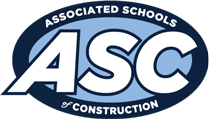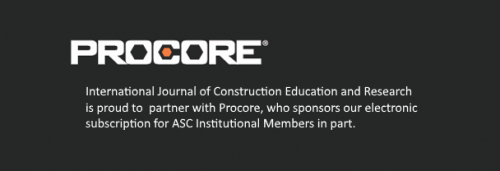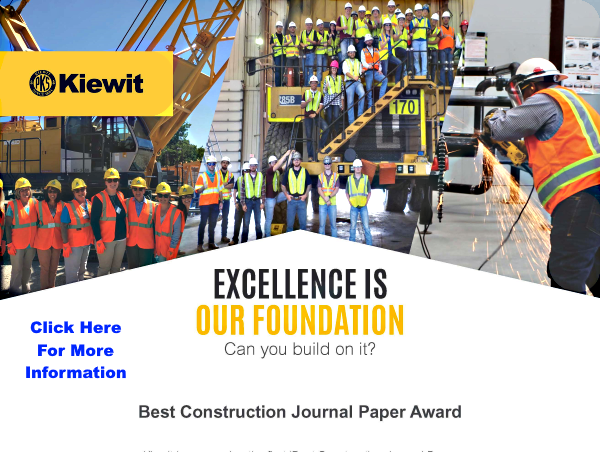Technical Tips for Journal Paper Submissions
The Editorial Office of the International Journal of Construction Education and Research is providing the following “Tips for Journal Paper Submissions” with the goal of establishing common editorial expectations for paper submissions. The document is meant as a general guide and is not meant to be exhaustive for all submission types and articles. Our tips are part of a larger effort to facilitate the review process.
ASC Writing Workshop Video: June 2016
Additional Sources of Information
We also recommend the following sources of information:
- “How to Write and Illustrate a Scientific Paper, Second Edition” by Bjorn Gustavi. University Press, Cambridge, 2008.
- “Scientific Writing: Peer Review and Scientific Journals” by Natalie H. Kuldell. From: http://www.visionlearning.com/library/module_viewer.php?mid=123
- “Writing a Built Environment Dissertation: Practical Guidance and Examples” by Peter Ferrel, Wiley Black-Well.
- “Tips for Writing Technical Papers” by Jennifer Widom, January 2006: http://cs.stanford.edu/people/widom/paper-writing.html
- Construction Economics and Management Journal Blog- a forum for authors, referees and readers: https://cmeforum.wordpress.com/
Journal Paper Submissions
The following outline provides a common set of paper sections and descriptions for technical papers submitted to the journal:
First, consider what type of study you are performing, here are some examples:
- Non-Empirical: This literature is comprised of no evidence and is often theoretical in nature.
- Qualitative (empirical): This literature is comprised of experience-based, case-based or interview-based evidence. A case study is one example of qualitative study.
- Quantitative Small and Large Sample: This literature is comprised of data collected from a small sample (typically less than 100) and a large sample (typically more than 100). With this type of study it is important to note the type of sampling (i.e. random, ordered), the type of data collection (i.e. survey) and the appropriate methodologies for testing (i.e. hypothesis testing, regression).
- Mixed-methods Research: “Research in which the quantitative approach or the qualitative approach, by itself, is inadequate to develop multiple perspectives and a complete understanding about a research problem or question.” (source: NIH website “methodology” tab).
Next, consider the following for your writing style:
- Active or passive voice? The tradition in scientific writing has been passive voice. Readers often prefer active voice.
- Tense. The tradition in scientific writing is to use PRESENT tense in the introduction, while the methods and findings/results sections are in the PAST tense, including your abstract for the study.
- Proven Facts. Scientific studies do not prove facts; they use hypotheses to suggest findings.
- Unnecessary hedging. Examples of hedging include using words like “could” “possibly” “might” or “may” too many times to remove the appearance of direct statements.
- Always run spell check on your final paper.
Winston Churchill was quoted as saying that speakers should “be short, be direct and be seated.” The same could be said of technical writing. Consider a concise and direct message for your work that flows logically. Your writing should lead the reader through the story of your work, building towards its findings.
Paper TitlePaper titles for technical papers can often be long (those which are very descriptive). However, many readers prefer a title that is short and to the point. A title in between the two options above is often the best one, but it must properly set the stage for the content of the paper. Many papers, whose title is different than the content of the paper, confuse the reader and reviewers.
The AbstractState the background, the problem, your approach and solution in the initial 2-3 sentences, Make sure to then describe the main contributions of the paper. Include little background and motivation for the work. Choose words carefully to represent the facts while not going beyond the facts. Your wording in the abstract section should not be repeated identically in the paper including the introduction to the paper. The abstract should also include the most important findings/results and remain below 300 to 400 words in length.
The BodyAside from these guidelines, which apply to every paper, the structure of the body varies a lot depending on content. Important components are:
1. The Introduction and Background
This section should provide a review of what others have done to address the problem and identify gaps that must be addressed or opportunities that present themselves to improve the state of the art. Take care NOT to present the literature review here, but only a summary of previous work that sets the stage for your work, the delineating point. The introduction should also clearly articulate the specific problem you hope to address within your scope of work, along with concise objectives that describe what your work will achieve if it is successful. Authors should clearly establish the boundaries and scope of the investigation and it is important to state the contribution of your work to the general body of scientific knowledge.
According to “Tips for Writing Technical Papers” by Jennifer Widom:
“The Introduction is crucially important. By the time a reviewer has finished the Introduction, she’s probably made an initial decision about whether to accept or reject the paper — she’ll read the rest of the paper looking for evidence to support her decision. A casual reader will continue on if the Introduction captivated her, and will set the paper aside otherwise. Here is the Stanford InfoLab’s patented five-point structure for Introductions. Unless there’s a good argument against it, the Introduction should consist of five paragraphs answering the following five questions:
- What is the problem?
- Why is it interesting and important?
- Why is it hard? (E.g., why do naive approaches fail?)
- Why hasn’t it been solved before? (Or, what’s wrong with previous proposed solutions? How does mine differ?)
- What are the key components of my approach and results? Also include any specific limitations.”
2. Literature Review
This section should provide a review of literature (scientific or otherwise) that addresses the problem and identifies gaps or opportunities that present themselves to improve the state of the art. The literature review should draw on seminal work while also explaining current and state-of-the-art thinking on the subject of your work. Literature review should focus no more than 10 years in the past with citations, unless seminal works are being discussed. Only a few seminal works should be discussed in the literature review as well.
In many ways, the literature review should set the stage for later findings, because the literature review represents the body of knowledge you are adding to. If findings support the literature, you will be stating this conclusion; if not, you will be refuting previous work.
3. Methodology
This section should describe the approach you will take to achieve the objectives of your work and/or answer your research question. It may include a discussion of the sample data you will study, sampling methods for data collection, analysis methods for that data, validation and reliability strategies. It should describe your overall research design and the steps you will take to complete your work.
The methodology section should include a description of how your work will be representative of the sample population. Depending on the type of article you are writing, impacts should describe how the answer to your research question will contribute to your sample population or how your useful outcome will benefit its user base.
4. Findings and Analysis
Once the data are collected, it is time to analyze and interpret results. Analysis should include summaries of data (e.g., descriptive tables, tables calculating means or variances) and any statistical tests that state and verify conclusions. Qualitative summaries will often include descriptive tables drawing conclusions across the results (i.e. demographics or commonalities of characteristics). Make sure to sequence and number all Tables and Figures, leading the reader to reach your conclusions. Make sure to reference the Table or Figure number in your writing as well.
To see more explanation of a proper strategy for writing results, go to:
http://abacus.bates.edu/~ganderso/biology/resources/writing/HTWstrategy.html .
5. Conclusions
This section should contain a short summarizing paragraph without repeating the exact language from the Abstract or Introduction. This is where the author(s) can reinforce their original hypotheses by referring to results of the study.
Conclusions are the researcher’s opportunity to provide context and interpretation to study results; to tell the reader why findings are important and matter, results or evidence presented do not speak for themselves.
It is important to note that to be acceptable for publication in the journal, papers must present new information. Papers that only contain a review of existing literature generally are not acceptable for publication, unless the review provides some new knowledge (i.e. a meta-analysis or theoretical framework).
Conclusions should also contain a section that states the limitations of the work- the sample you will study, sampling methods for data collection, analysis methods for that data, validation and reliability strategies.
Finally, it is important to discuss future research directions for the work and any follow-up work you or your colleagues might be planning.
6. Acknowledgements
Make sure you acknowledge those who contributed through: discussions, edits, expert panels, implementation or sponsoring the work.
7. References
Spend the effort to make all citations complete and consistent. Check over your final bibliography carefully and make sure every entry looks right.
8. Appendices
Appendices should include all material that is difficult to explain concisely in the body of the work and that might disrupt the flow of the writing. That said, it should not contain material necessary for understanding the paper.
If survey data is used in the paper, a copy of the survey instrument or a listing of the questions asked should be included as an appendix. Even if the survey appendix is not published, including it in the review process is important for reference.



